The Virtue Audio Sensation
Virtue Audio has recently released its new “Sensation” integrated amplifier, available in two standard versions and with a range of power supply options. Seth Krinsky of Virtue Audio talks with John Reekie about the Sensation amplifier, and other trials and tribulation of being in the audio industry.
JR – Seth, when did you start Virtue Audio?
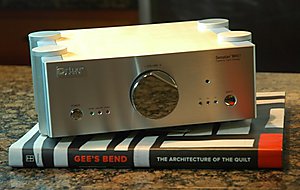 SK – My high-end audio journey actually started at Sound By Singer in Union Square around 10 years ago. I had been wandering by the shop during a lunch break in the roaring “dot com” era and became entranced by the sound of a pair of Meadowlark Kestrels. I’d never heard anything like them before. I ended up buying that pair for a friend for his wedding, and promising myself that one day I’d have a pair of my own.
SK – My high-end audio journey actually started at Sound By Singer in Union Square around 10 years ago. I had been wandering by the shop during a lunch break in the roaring “dot com” era and became entranced by the sound of a pair of Meadowlark Kestrels. I’d never heard anything like them before. I ended up buying that pair for a friend for his wedding, and promising myself that one day I’d have a pair of my own.
High-end audio was, for me, like discovering bed and breakfasts after years in HoJos. [Editor’s note: a budget chain of hotels in the United States.] Wow, it was all so cool. Real artists and real engineers. Real metal. Glass tubes. Gorgeous finishes. Leather. No, too little leather. Once I discovered audiogon.com, the addiction began in earnest; on the used market, I could suddenly afford this stuff. Pretty soon I did own some Meadowlarks – Shearwater Hotrods – and a gorgeous pair of Antique Sound Labs (ASL) 805 monoblocks.
In late 2005, I travelled to China to visit my cousin and made a point of stopping by the factories where the ASLs and some other gear was made. I asked Joseph Lau of Antique Sound Labs how much it would cost to make an aluminum enclosure similar to what he was building. His response? “Well, how much does it weigh?”
Aha! It occurred to me at that moment, that if I could justify the cost of the metal in my products I’d never have to make anything from plastic. That’s when I decided in earnest to start Virtue.
JR – What possessed you to do it?
SK – Frankly, I was annoyed that good hi-fi was so expensive and, like most of my customers, believed that there was a conspiracy to inflate prices. Now that I know the manufacturing and R&D process, I’m not nearly as incensed by high prices. Many of the high-end boutique manufacturers in this industry are barely hanging on and sell only a handful of those expensive units per year.
Of course, I was predisposed to it as well. My mother is an artist and her father’s a carpenter. So making things of function and beauty is somewhat in the blood, so to speak, and yeah, there’s a bit of insanity as well.
JR – Tell us about the Tripath chips used in your amplifiers. You’re obviously not concerned about hiding the technology you’re using – do you see the Tripath as a marketing advantage, or is it just a matter of being open about what you’re doing?
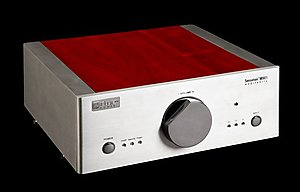 SK – Why would I deny Dr. Tripathi the recognition he deserves as a visionary in digital audio? His approach was at least a decade ahead of competitors and has a euphonic sound that nobody’s yet matched in silicon. Tripath is a badge of honor and anyone who has heard a Tripath amp, particularly a well-executed one like ours, will forever have a soft-spot for their distinctive sound.
SK – Why would I deny Dr. Tripathi the recognition he deserves as a visionary in digital audio? His approach was at least a decade ahead of competitors and has a euphonic sound that nobody’s yet matched in silicon. Tripath is a badge of honor and anyone who has heard a Tripath amp, particularly a well-executed one like ours, will forever have a soft-spot for their distinctive sound.
Others were not so generous to Tripath. For instance, the wireless audio market leader, Sonos, used Tripath amplification until recently. They taunted the Tripath salesman year after year, saying that his technology would be replaced. The English maker Chord has used the technology and told nobody. Bel Canto dropped Tripath ingloriously, after producing what some consider the best amps that company ever made.
It was nice that Sonic Impact made Tripath famous – they had the decency to call their amp the “T-Amp” – but it was sadly too late. Yes, Tripath was mismanaged, but they didn’t deserve to die and be sold for so little, so soon.
JR – You’re making these offshore – how is that working out? What advice would you give to someone contemplating doing the same?
SK – Well, we spent more on shipping than we sold in amplifiers during the first few years. So, it’s not all roses, that’s for sure! But with the extensive metal-work we have on these machines, building here (in the USA) would have been really expensive. The DIY kit and “box ‘n’ faceplate” folks have a much easier time with domestic production.
Moving forward, we will probably build more in the USA — but we’ll never abandon our core Asian manufacturing partners. They do fantastic work and when we start expanding into higher volume channels, we’ll be increasingly reliant on their ability to scale up.
JR – What’s the absolute bestest thing that’s happened to you as a result of running Virtue Audio?
SK – Without question it’s the relationships I’ve made. I started Virtue as a frustrated customer and have very egalitarian relationships with my customers. The main difference between me and them is that I’m crazy enough to bankroll the construction of very large numbers of these wonderful devices.
JR – What’s your favorite loudspeaker?
SK – It’s really not good business for me to have a preference in loudspeakers. We partnered with a number of great companies at RMAF last year including Ascend Acoustics, Omega, GR Research, Usher, AudioEngine and Silverline. They each make wonderful speakers and I highly encourage my customers to buy them! Ascend and GR Research are both reselling our amps and we’re starting to carry some Ascend speakers; these synergies are a real win-win.
In terms of specific models, I will say that listening to a pair of Danny Richie’s V1s at RMAF (Rocky Mountain Audio Fest) 2009 was so mind-blowing that we shifted our product strategy based on what we heard there. They’re enormous and heavy and expensive, and I don’t expect to own them soon, but wow, they were wonderful.
JR – So you’ve recently launched the Sensation amplifier. Can you tell us about the heritage of this amplifier – is it an evolution of your smaller Virtue ONE and TWO amps, or something different?
SK – Although they share some core components, the Virtue and Sensation amps are completely different animals.
Their creation story begins more than four years ago when I was leaning heavily on my manufacturing partners Keiga and AudioPower to design the amps based on loose specifications. I designed the enclosures myself and they created the first boards.
At times during their development, features spilled over between units. For instance, the Sensation always had 2 power chips running in mono bridged output mode and when we saw the benefits, we copied that feature to the smaller amps. But besides the main ICs and some output filter capacitors, the BOMs are quite different.
JR – I understand that the product development cycle was quite long. Can you tell us a bit about that? Any key “I’ll never do that again” lessons learnt?
SK – Indeed, John!
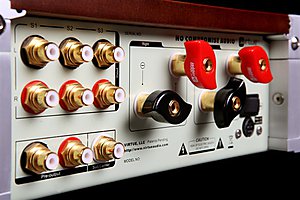 About a year into development I presented my 100% Asian designed and built prototypes to Jeff Fox of Command AV in Virginia. Jeff got me started in the business after selling me a pair of used ASL Explorer monoblocks and Meadowlark Shearwater Hotrods. He hooked up the prototypes to his Usher Tiny Dancers in his well-treated listening room. He shrugged and muttered, “Pretty good for the money”… which in audiophile-speak means one thing only: “crap.”
About a year into development I presented my 100% Asian designed and built prototypes to Jeff Fox of Command AV in Virginia. Jeff got me started in the business after selling me a pair of used ASL Explorer monoblocks and Meadowlark Shearwater Hotrods. He hooked up the prototypes to his Usher Tiny Dancers in his well-treated listening room. He shrugged and muttered, “Pretty good for the money”… which in audiophile-speak means one thing only: “crap.”
I found Roger Sheker while shopping for Auricaps to give the amplifiers an “edge” in the marketplace. Roger is a quirky engineer who every few years spits out something truly wonderful for Audience, makers of Auricaps, aR power conditioners, Auric cables, and other fantastic products. He had some experience with Tripath and we struck up a consulting partnership.
It took Roger’s intuition and experience to bring out the full potential of the Tripath platform. A prominent Chinese dealer once told me that he is presented with hundreds of gorgeous audio products made by Asian boutique manufacturers every day – you can just imagine. Many look great, but most sound awful. There really is an art to amplifier design and guys like Roger are artists.
While we knew the little “Audiophile” amp (the name was changed to “Virtue” later for trademark reasons) was really special, Sensation was really stealing our attention. Just prior to RMAF, Roger took it over to John McDonald’s house (John owns Audience) to hear how it sounded “on the big system.” I remember getting that phone call that day… they were both absolutely speechless. Sensation was so good that it was upping the ante for their cost-no-object Hypex-based model. With the blessing of two of the most critical listeners in the business (Roger and John), we quickly built a dozen prototypes. After years of development we were rushing Sensation out the door and excitement was very high.
But not everything was perfect in Virtue-land. The good news was that Sensation sounded great with a 38 V power supply, and fit nicely into our product line as the next, higher-power, step up from the little Audiophile amp (code-named “Target” and now known as the “Virtue”). The bad news is that four of the six prototypes we had expressed to the show blew up there. But that’s not all.
During that week our key reviewers had also received their Sensations. David Kan (of 6Moons.com) emailed me during the show to tell me that his amp smoked after a most wondrous orchestral passage. Ditto our Positive Feedback reviewer. I quickly notified James Darby (Stereomojo.com) to dial back his power supply to 30 V and “go easy” on the amplifier. And just like that, with several orders already booked, Sensation was withdrawn from the market and we set to the task of figuring out what was wrong.
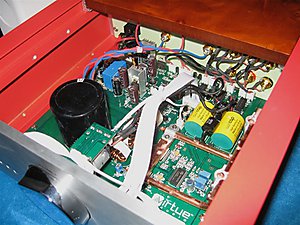 A really wonderful part-time engineer, Ivan Kruglak, had joined our team part-time to solve the riddle, which he did. There were certain circuit board traces in Sensation that were quite long and at high voltages caused a problem. Roger’s design philosophy was weighted heavily toward component selection and signal path simplification. And while he had been reworking the design for more than a year, the PCB layout was still off-shore, and these capacitance issues at high voltages just slipped through the cracks without a sonic trace.
A really wonderful part-time engineer, Ivan Kruglak, had joined our team part-time to solve the riddle, which he did. There were certain circuit board traces in Sensation that were quite long and at high voltages caused a problem. Roger’s design philosophy was weighted heavily toward component selection and signal path simplification. And while he had been reworking the design for more than a year, the PCB layout was still off-shore, and these capacitance issues at high voltages just slipped through the cracks without a sonic trace.
Around the same time, Roger fell ill and Michael Mardis, a T-Amp specialist adored by our customers, joined the team to help manage new development. But like Roger, layout was not his specialty. So we hired a US-based PCB layout engineer to commit changes to silicon. The new guy had a very impressive resume and embraced our projects enthusiastically. No job was too hard and he didn’t anticipate any difficulty. Whether it was his positive outlook, English accent, or seemingly solid knowledge of what we were doing, we were thoroughly seduced and I agreed to a great deal of rework and new projects. Sensation would be redone from scratch and the “Target” platform beneath the little amps would be traded up to the spiffy new, dual-mono “X1,” and Michael would get the DAC he always wanted. Work was underway at “full-speed” and prototypes were promised imminently.
Along with my patient international dealers, we waited for one prototype and then another and Spring flowers became the 4th of July became Fall and then Halloween. Tension mounted and tempers flared. The units we presented at RMAF 2009 were not production-ready, despite my bold announcements and attractive marketing collateral. Having sold out of the little amplifiers months prior, our shelves were completely empty. On top of it all, Michael had some family challenges and no longer had time to supervise. We were a “Mom and Pop” shop without Mom or Pop, and our shop was empty. ICEBlock (ICE-based high-power amplifier) and Piano (CD player) were appearing at the Port of NY… but our core amplifier products were nowhere to be seen. Houston, we had a problem.
Amid the burning wreckage of RMAF 2009, though, there were angels looking over us. The first was James Darby who had dropped by our room to present us with the StereoMojo Best Value of the Year Award for the Virtue ONE. In passing, his wife Linda said something very interesting. “You know that James has been using your Sensation amp as a reference for more than a year now…” I did a double-take. Wha..? James has access to anything made. Sensation was a reference amp? We’d pulled her from the market before seeing how she trotted, and boy that Sensation could run.
And then there was Danny Richie of GR Research with his magical V1s and sound-treated room. Danny is a Gary Dodd acolyte and battery bigot. He insisted that we trade out our switching supplies for batteries, which Vinnie Rossi of Red Wine Audio had generously provided. While the RWA Black Lightning sounded good in our room, we hadn’t the resolution to really hear the difference. In Danny’s room, the results were astonishing. It occurred to me then that what we were doing with 24V battery supplies was much more than adequate – it was extraordinary.
This was the second big “Aha!” The solution had presented itself. We had great amplifiers that loved the taste of high-current power supplies, especially batteries. With the oversight of Ivan and to a lesser extent, Michael, we asked our Asian partners make a few nips and tucks and went back into production.
But the supply interruption, pre-announcements, reversals, and inconsistent messaging had created tremendous confusion. Thankfully, that’s the past. Our customers today are as happy with their Virtue amps as our customers last year. The power supply options are very well received and most customers like the stepped attenuators. We’re also working with a new engineer who has additional PCB layout skills that we were really missing. I can now sleep at night, knowing that these debacles will never occur again.
JR – And the case… quite innovative, with the ability for customers to swap out a range of sides and tops at will. Faceplates too I believe. Why?
SK – Well, why not? Why shouldn’t you be able to change the face and top and sides to suit your room and decor?
Our units were designed from the very beginning to coexist in rooms with furniture, artwork, and… people. And because the business model was going to be internet-direct, it seemed logical to me that we would build to order.
The build quality I tried to achieve is what you may find in really high-end pieces that are delivered in velvet bags and sit like trophies in fancy AV racks. Those pieces stir the imagination and I wanted to bring that sensory excitement to customers of more limited means.
In truth though, I did expect that a fair number of hipster professionals, and women, would be buying these units for their swanky city apartments. Not in my wildest dreams did I imagine that 99% of our customers would be audiophiles fully capable of appreciating less attractive gear. We do have one or two female and perhaps as many non-audiophile customers. If you know of any others who might need a good sound system, please do send them our way.
But in fact our customers do appreciate the “Melissa” platform. In addition to mixing and matching colors, several of our customers have done amazing custom creations. A guy in England, for instance, did some things with carbon fiber that blew my mind. We expect more such experimentation in the future — marble, granite, tiles, textiles, beads… whatever. The platform is art.
JR – So, who is buying the Sensation?
SK – Since we sold all of our early prototypes for cash, there’s actually not a single review out there yet on Sensation – so very few people know just how good it sounds. As of today, most Sensations are sold to ONE/TWO customers who already know, trust us, and want more inputs and a remote. However, I’m hoping to broaden that audience soon. The reviewers looking at Sensation right now just love them and I don’t think we’re going to get any back.
They’re aggressively priced – quite close to the intro price from 2008 – and I don’t know of a better value for the sophisticated buyer. You can print that.
JR – Do you get many returns?
SK – Sensation can’t drive every speaker on the market well (87 dB/W/m or more is recommended) so you’d think we would get more back. But we don’t. I issued an RMA recently for a guy who wanted to build his system around some gorgeous Totem Arrows, which we don’t drive very well. However, he was so overwhelmed by our performance on his less attractive Klipsch Horns that he put the Totems to the side and kept Sensation in his main system. Returns to date are under 5%.
JR – Tell us about power supplies. The Sensation has a four-pole filter capacitor in the power supply. Yet significant improvements are heard with higher-current and battery supplies?
SK – At this level of performance, it all matters. The caps, the power supplies, the inductors, everything.
In the near field, many of our customers are perfectly happy with the stock 65 W, for “burn-in only” supply. It’s actually a really good supply. But the high-current supplies do take the amps to another level. Some customers swear by the big, ugly Astron supply. Others prefer batteries. On sensitive speakers (>90 dB) we suggest batteries. Gary Dodd has agreed to make us some less expensive, plug-and-play battery kits, and Red Wine Audio continues to sell the Bentley which they call Black Lightning.
JR – Other than the external power supply, are any of your customers doing mods to these amps? Does it even make sense to do that with the Sensation?
SK – Unlike most Tripath amps, ours are highly optimized straight from the factory. Roger was a stickler for picking the right parts for every job and we’ve been really good about not cutting corners. Except for a handful of very standard parts, I buy each part myself and air-ship them to my manufacturers. We give them very little discretion.
But there is still room for improvement. My “golden ear” customers are tweaking the input capacitors and of course power supplies, with great results. We’re starting to see customers replacing the volume potentiometer as well, although the stock unit is actually quite good. These amps were designed for keeping, so over time I expect more modding to occur as our audiophile customers strive to improve upon perfection. Of course, they’re not perfect, but that urge is natural and normal among all audiophiles.
JR – What’s changed in the industry since you started Virtue?
SK – This industry is evolving incredibly quickly and it’s a real challenge for all of us vendors. With the economy in tatters, demand for discretionary gear has declined considerably. At the same time, material and labor prices have gone up. Our cute Propeller Post binding posts are twice as expensive as when we started.
As with computing, the ICs used to drive these products continue to get better, more integrated, and easier to implement. We spent 3 years and mortgages worth of money developing a great sounding Tripath TC200x board. The new IR boards require one email’s worth of engineering and are really quite good sounding, stock.
Finally, we are now often competing with the businessmen who make our own products, directly. eBay and air-mail are truly cutting out the middle-man. Commoditization is coming slowly but surely to this industry, particularly in the budget space.
So… should we double our prices?
JR – And, are you happy about Virtue now?
SK – Creating a brand like Virtue is very satisfying. Virtue is what it means and I’m very proud to be its parent. It’s not Mid-East peace, but it’s pretty cool being one of the most high-value crack dealers in hi-fi.
Last weekend (May 15th/16th), we played the Lone Star Audio Festival. Would you believe that one of my customers from Missouri drove 8 hours with his wife and Sensation system, to host a second Virtue room at the show? He brought his Gallo Stradas and a little sub and the sound was mesmerizing – one of the most natural, open, and airy at the show. If your customers are that excited about your products, what’s there not to be excited about yourself?
JR – How many amps do you have running in your own house?
SK – The love of my life (Melissa) lets me run a blue Virtue ONE with the 30V/130W PSU. David Fabrikant at Ascend heard my plight and sent over the most wonderful sounding CBM-170 bookshelf speakers. The black finish was a big hit and their compact size got them in under the radar. The setup does sound fantastic but I do miss the beloved Meadowlark Shearwater Hotrods, which were too ugly and now sit panting and warping, in storage.
She says that if I sell out my 2010 inventory then maybe I’ll get a… Sensation M901, the one with the Auricaps. I told her that I’d really love a matching Piano, and that I’d build it with blue sides and blue buttons. She loves blue…
But yes, they’ll take up some space on the end-table and no, they won’t just disappear…. Why would you want to do that? And yeah, more inputs means more wires. The battery pack is ugly? Yeah, she’s right about that. Vinnie?
It can be rough out here for an audiophile.
Basic technical specifications
Dimensions: 4″H x 10.5″W x 10″D
Power output: 30 watts per channel (4 ohms, 24 V / 65 W power supply)
Power output: 87 watts per channel (4 ohms, 30 V / 300 W power supply)
Inputs: 3 x RCA inputs
Outputs: Stereo preamp outs, buffered mono subwoofer out, speakers outputs using Propellor posts
Manufacturer’s website
http://www.virtueaudio.com/
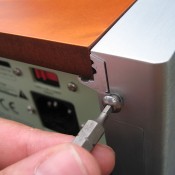
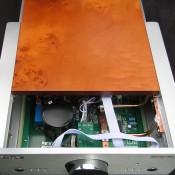
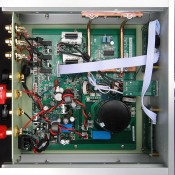
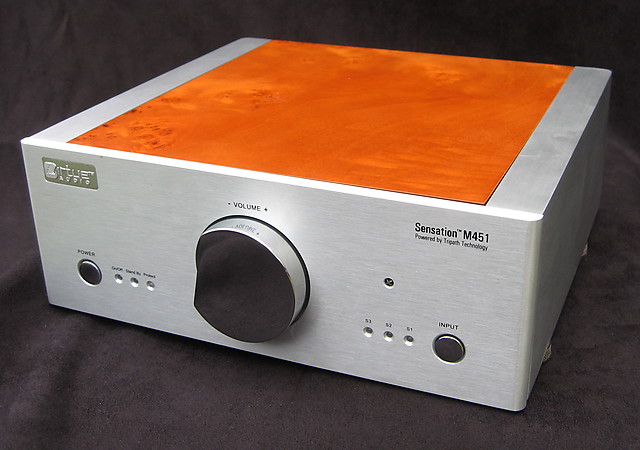




Seth, what a wonderful article! Open and from the heart. Any of us who have struggled to bring our vision into reality can relate to what you’ve been through (though it sounds like you got more than your fair share of struggle!). Your perseverance is inspirational, and lets the rest of us know that we’re not alone, and that it’s worth dealing with all the setbacks (both little and big). I tip my hat to you on your making that extra effort to take care of your customers. In one sense what we do is facilitate music working its magic for as many people as possible, and in doing so I like to think we’re making a positive contribution. You’re making music’s magic significantly more accessible.
Just for the record, I endorse Seth’s amps wholeheartedly. His amps are NOT in a category I normally gravitate towards, but they are the exception to every negative “rule” I once embraced about relatively affordable compact amps. I would not hesitate to recommend Virtue amps to anyone looking for amps anywhere remotely near their price range on sonic merits alone, totally apart from their raging coolness/cuteness/practicality.
Duke LeJeune
AudioKinesis
As a long term audio-/musicophile (30+ years)and recent “first time” attendee to this years LSAF in Dallas, both my wife and I were doubly impressed as well as “blown away” by the sytems on display in both Seth K’s and Duke’s ( a fellow Louisiana “native”) room(s).
They both exhibited a real passion for their respective artistry AND willingly shared their knowledge from a solid engineering perspective….both attributes that ANY of us involved in this hobby can truly admire.
We weren’t alone in our assessment as evidenced by the number of times we tried to return and get a seat for a “second” or “third” listen…to no avail as their rooms were consistently filled with like minded admirers who reveled in the sound of their respectively assembled systems.
Without a doubt, we are now trying to “prioritize” our future audio budget to support the work these two fine gentlemen so passionately contribute to our enjoyment of music…..all “within reach” of those with somewhat modest means…and a fantastic VALUE for ALL of us.
Kudos! Seth and Duke!
Mark and Sandra Hawkins
Houston, Texas
Im not even a customer yet and I have found Seth to be a thoughtful and sincere gentleman.How many companies do you know where the principle responds to email on a Saturday night!!!! My short list of products I hope to own is down to ONE or TWO and they all come from Virtue!!!
My journey that led me to owning the M-901 started with the DIY crowd and specifically GR Research and Danny Ritchie. I am currently finishing a set of GR speakers and I haven’t had the luxury of hearing this beautiful amp that sit’s patiently in my listening room. But one thing I have certainly come to know about the Gary Dodd’s, Danny Ritchie’s, and the Skiing Ninja Sean’s of the small scale DIY world; these people truly care about their product and customer. Seth is absolutely one of these and certainly one of the nicest people I’ve ever dealt with.
I can barely contain myself for the day where I can here my system!
Dave Welch
Yellowknife NT Canada